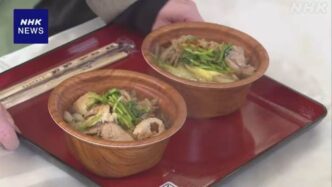By-Bani Thakur
(Image Credit:https://www3.nhk.or.jp/nhkworld/en/news/20251012_01/)
Accompanied by crisp autumn air and golden rice stalks bowing under the weight of the season’s bounty, Akita Prefecture is currently celebrating a beloved tradition: the kiritanpo food festival. In Odate City, where the dish has deep roots, locals and visitors have gathered to mark the opening of kiritanpo season with the first harvest of Akitakomachi rice, bringing together community pride, regional flavors, and culinary charm.
What Is Kiritanpo?
Kiritanpo is one of Akita’s most iconic homegrown foods. It starts with freshly harvested rice, pounded just enough that it holds together but retains some texture. The mash is formed around cedar skewers and grilled over a fire until the exterior gets a golden char and smoky aroma.
The rice tubes can then be served as-is, brushed with miso or soy sauce, or cut from the skewer and dropped into a hearty hot pot (nabe) featuring local ingredients—most famously Hinai-jidori chicken, seasonal mushrooms, burdock root, green onions, and Japanese parsley.
The Festival Kick-Off: New Rice & Community Spirit
This year’s festival officially began in Odate City with a celebration of the freshly harvested Akitakomachi rice. Members of the Akita Meibutsu Honba Odate Kiritanpo Kyokai prepared the first batch of kiritanpo using the new rice, serving as a symbolic milestone for the harvest season.
The event drew crowds eager to taste the difference new rice brings: sweeter, more fragrant, with a freshness that lingers. Beyond just food, the gathering is steeped in ritual—people sharing meals, comparing recipes, and rejoicing in the culmination of months of agricultural effort.
Why It Matters: More Than Just a Dish
- Cultural Heritage: Kiritanpo is more than a comfort food; it’s a link to Akita’s history. It is said to have originated among mountain hunters and rural communities, who needed nourishing, portable food in harsh conditions. Over time it became a staple in family meals, seasonal gatherings, and community celebrations.
- Agricultural Identity: The use of Akitakomachi rice—a premium variety known across Japan—underscores the importance of local farming. Festival‐time showcases how rice grown in Akita (long a major rice‐producing region) isn’t just an economic product, but also a source of identity and pride.
- Tourism & Experience: Alongside the food, visitors can join interactive experiences: watching the making of kiritanpo, cooking workshops, tasting sessions, and mingling with farmers, cooks, and locals. It’s a chance to savor the season in a convincing, sensory way.
What Visitors Can Expect
- Freshly grilled kiritanpo to try on its own, or dipped and simmered in hot pot broth.
- Seasonal side dishes made with local mushrooms, root vegetables, and Hinai chicken.
- Demonstrations of traditional cooking techniques—like forming the rice mash and grilling it over charcoal or cedar, which contributes both flavor and aroma.
- A chance to taste mismatches: miso glazed, or soy sauce brushed, or even newer riffs on the classic.
- Cultural performances, local music, dance, market stalls, and plentiful hospitality.
When & Where
The festival tradition in Odate typically takes place in early autumn, shortly after the rice harvest. This year, the opening ceremony with fresh Akitakomachi rice has already been held.
Venue locations often include outdoor market grounds and community centers, where food stalls and cooking stations are set up. Some events also include workshops (e.g. in Odate’s “Kiritanpo Kobo” or other local cooking venues) where participants can try their hand at making kiritanpo themselves.
Taste This If You Go
If you visit, here are some tips for fully appreciating the experience.
- Go early in the season, while the new rice is fresh—it really makes a difference.
- Try multiple styles: grilled plain, miso-coated, or simmered in nabe. Each method highlights a different side of kiritanpo.
- Pair it with local vegetables—the earthy mushrooms or the crispness of burdock root bring out the texture of the rice tubes.
- Talk to the makers: often elderly farmers or cooks keeping old traditions alive; their stories enrich the flavor.
In Summary
The kiritanpo festival in Akita isn’t just a food event—it’s a harvest celebration, a cultural connection, a statement of identity. As autumn transitions into winter, there is something deeply renewing in gathering around smoky grills and steaming pots, sharing warmth and rice, and honoring the land’s yield. For anyone wanting an authentic taste of Akita, the festival is a must-experience.
Source:https://www3.nhk.or.jp/nhkworld/en/news/20251012_01/

















